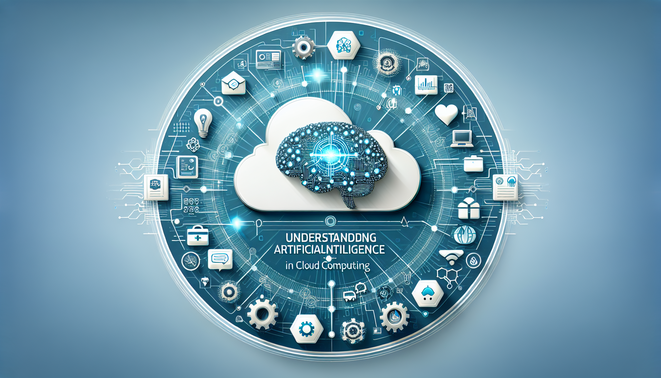Physical Address
304 North Cardinal St.
Dorchester Center, MA 02124
Physical Address
304 North Cardinal St.
Dorchester Center, MA 02124

Understanding Artificial Intelligence in Cloud Computing
Meta Summary: Discover how Artificial Intelligence (AI) is revolutionizing cloud computing, enhancing business processes, and driving digital transformation. Learn about AI’s core components, its role in industries, and strategies for adopting an AI-first approach.
Artificial Intelligence (AI) is revolutionizing business and technology. Integrating AI into cloud computing is a pivotal step for organizations worldwide, enabling them to revolutionize processes, enhance decision-making, and drive innovation. This article explores AI’s fundamental concepts, their role in digital transformation, and strategies for integrating AI into enterprise workflows. We’ll also delve into practical AI-powered cloud services and illustrate these concepts with real-world case studies.
Introduction to Artificial Intelligence
Artificial Intelligence is a branch of computer science focused on developing intelligent systems capable of mimicking human behavior. Core components include machine learning, natural language processing, and robotics. Over the years, AI has evolved from simple rule-based systems to sophisticated algorithms that learn and adapt.
Learning Objectives
Define Artificial Intelligence and its core components.
Describe AI’s historical evolution and its future potential.
Case Study: IBM Watson in Healthcare
IBM Watson’s success in healthcare beautifully illustrates AI’s potential. Watson uses AI to aid doctors in diagnosing diseases, analyzing patient data, and recommending treatments. This case study exemplifies AI’s ability to support medical professionals and improve patient outcomes.
Distinction Between AI, Machine Learning, and Deep Learning
Grasping the distinctions between AI, machine learning, and deep learning is crucial to understanding their applications. AI encompasses the creation of systems with human-like intelligence. Machine learning, a subset of AI, focuses on data-driven algorithms that mimic human learning. Deep learning, a subset of machine learning, uses neural networks with many layers to analyze complex data patterns.
Learning Objectives
Explain the differences between AI, machine learning, and deep learning.
Provide examples of applications for each concept.
Exercises
Research and present on a practical application of AI in a specific industry.
Create a comparison chart outlining the differences between AI, machine learning, and deep learning.
The Importance of AI in Digital Transformation
Digital Transformation involves integrating digital technology into all business areas, fundamentally altering operations and customer value delivery. AI significantly contributes to this transformation, enhancing processes, optimizing operations, and enabling data-driven decision-making.
Learning Objectives
Comprehend AI’s role in digital transformation.
Understand AI’s impact on business processes and decision-making.
Case Study: AI in Retail
In the retail sector, a company successfully used AI to predict customer behavior and manage inventory. By analyzing extensive consumer data, AI systems provided valuable purchasing trend insights, leading to better stock management and personalized marketing strategies.
AI-First Organizations: A New Paradigm
AI-first organizations prioritize artificial intelligence technologies in processes and decision-making. This strategic approach offers competitive advantages through innovation, efficiency improvement, and enhanced customer experiences.
Learning Objectives
Define AI-first organizations.
Discuss the strategic value of prioritizing AI in business models.
Case Study: Google
Google exemplifies an AI-first organization, having AI-driven innovations at its core. From search algorithms to autonomous vehicles, Google uses AI to push technological boundaries and improve user experiences.
Best Practices
Consider ethical implications when developing AI solutions.
Start with small-scale AI projects before full-scale implementation.
Pitfalls
Assuming AI can solve complex problems without proper data.
Neglecting the importance of training stakeholders on AI capabilities.
Practical AI-Powered Cloud Services
Cloud providers offer an array of AI services that enable organizations to integrate advanced capabilities easily. These services include machine learning platforms, natural language processing APIs, image and video analysis tools, and more.
Learning Objectives
Explore various AI services offered by cloud providers.
Discuss use cases for leveraging AI in cloud environments.
Exercises
Select a specific AI cloud service and create a use-case scenario.
Develop a simple project using cloud provider AI services.
Integrating AI into Enterprise Workflows
Integrating AI into enterprise workflows demands careful planning and execution. Key steps include identifying processes for AI enhancement, ensuring data quality, training employees, and continuously monitoring AI performance.
Learning Objectives
List steps for incorporating AI into existing workflows.
Identify challenges and find solutions for AI implementation.
Best Practices
Continuously supervise AI performance and adjust as necessary.
Establish clear AI governance to ensure compliance and ethical use.
Pitfalls
Overlooking the necessity of clear AI governance.
Ignoring scalability and integration challenges.
Visual Aids Suggestions
Diagram illustrating the relationships between AI, machine learning, and deep learning.
Flowchart showing digital transformation process steps and AI’s role.
Key Takeaways
AI’s transformative force: Enabling smarter and more efficient business operations.
Distinctions matter: Differentiating AI, machine learning, and deep learning helps in effective technology application.
Embrace AI-first: Gain competitive advantages by prioritizing AI in business strategies.
Cloud-based AI: Offers scalable solutions for integrating AI across various industries.
Integration essentials: Requires careful planning, ethical considerations, and ongoing performance monitoring.
Glossary
Artificial Intelligence: Developing intelligent machines mimicking human actions and reactions.
Machine Learning: Subset of AI using data and algorithms to mimic human learning processes.
Deep Learning: Uses multilayer neural networks to analyze complex data.
Digital Transformation: Incorporating digital technology to fundamentally change business operations and customer value.
AI-First Organization: Prioritizes leveraging AI technologies for streamlined processes and decisions.
Knowledge Check
What is the main difference between AI and machine learning?
A) AI is a subset of machine learning.
B) Machine learning is a subset of AI.
C) Both are the same.
D) AI and machine learning are unrelated fields.
Explain how AI can enhance customer service in retail.
What are key steps for integrating AI into enterprise workflows?
Further Reading
IBM Cloud: What is Artificial Intelligence?
Microsoft Azure: What is AI?
Forbes: What Is An AI-First Company?